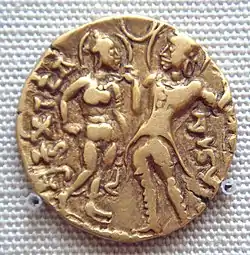Licchavi (clan)
The Licchavis were a clan amongst the Vajji Mahajanapada of ancient India. Vaishali, the capital and homeland of the Licchavis, was also the capital of the Vajji mahajanapada. It was later occupied by Ajatashatru, who annexed the Vajji territory into his kingdom during the Magadha-Vajji war.[1][2][3]

Kautilya in his Arthaśāstra (ch. XI), describes the Licchavis as a republic (gaṇa sangha), whose leader uses the title of rājā (rājaśabdopajīvinah). A Buddhist text, the Mahāparinibbāna Suttanta refers them as Kshatriyas and one of the claimants of the relics of Shakyamuni Buddha. They have claimed Kshatriya status themselves.[4] According to the Dīgha Nikāya, the Licchavis were of the Vasiṣṭha gotra.[5] Buhler assumes that, in the Manusmriti (X.22), the Licchavis are placed in the category of the Vratya Kshatriyas.[6][7]
Buddhaghośa in his Paramatthajotikā, traced the origin of the Licchavis to Benaras. The date of the establishment of the Licchavi domination over the area consisting of present-day north Bihar and Terai region of Nepal is not known. By the time of Mahavira and Gautama Buddha this clan was already well settled in the area around their capital Vaiśālī. Buddhist tradition has preserved the names of a number of eminent Licchavis, which include prince Abhyaya, Oṭṭhaddha (Mahāli), generals, Sīha and Ajita, Dummukha and Sunakkhata. The Kalpasūtra of Bhadravāhu refers to the nine Licchavi gaṇarājas (chieftains) who along with the nine Malla gaṇarājas and the eighteen Kāśī-Kośala gaṇarājas formed a league against Magadha. The leader of this alliance was Chetaka, whose sister Trishala was the mother of Mahavira.[8]
Licchavi administration

Only scattered reports of the Licchavi government system survive. The introductory portions of the Cullakalinga Jātaka and the Ekapaṇṇa Jātaka mention the Licchavi as having 7,707 Rājās. The number is one of convention, and unlikely to have been exact. It does demonstrate that Licchavi, unlike most of its neighbours, was not an absolute monarchy. Ultimate authority rested with the 7,707 raja who met each year to elect one of their member as ruler and a council of nine to assist him.[9] It was far from a modern democracy, as only a small portion of the Licchavi population qualified to vote. Those with raja status were only the male heads of households who belonged to the kshatriya varna.
The seat of the Licchavi administration was in Vaiśālī, the capital of the Vajjiian confederacy. The Rājā was the highest executive and judicial authority.[10] The introductory portion of the Bhaddasāla Jātaka mentions a tank, the water of which was used for the Abhiṣeka (the coronation) of the Gaṇarājas of Vaiśālī. The assembly hall where these Gaṇarājas met for discussion was known as the Santhāgāra.[11]
The executive
The Aṭṭhakathā mentions three chief functionaries of the Licchavi administration, the Rājā (the ruling chief), the Uparājā (the deputy chief) and the Senāpati (the chief of the army).[10] The introductory portion of the Ekapaṇṇa Jātaka adds one more with it, the Bhāṇḍāgārika (the chancellor of exchequer).
The judiciary
.png.webp)
According to the Aṭṭhakathā, an accused criminal had to pass through seven layers of judges, each of whom investigated and interrogated the accused.
These judges were the Viniccaya Mahāmātta (the inquiring magistrate), the Vohārika (the jurist-judge), the Sūttadhāra (the master of the sacred code), Aṭṭhakūlakā (literally, the eight clans, probably a federal court). Then the Senāpati and the Uparājā. The final judge was the Rājā, who could find him guilty, whereupon the convict received the punishment prescribed in the Paveṇipotthaka (the book of precedence) for the offence committed by him.[11]
Decline
The Licchavi feud with Ajatashatru from 484 BCE to 468 BCE ended with the victory of the latter.[12]
Licchavis and the Imperial Guptas

The Licchavis continued to live in the region of Vaishali during the Gupta period and formed an integral part of the Gupta Empire.[13] The Gupta emperor Chandragupta I married a Licchavi princess Kumaradevi and the legend Licchavayah is found along with a figure of goddess Lakshmi on the reverse of the Chandragupta I-Kumaradevi type gold coins of Samudragupta.[14] In the Allahabad Pillar inscription of Samudragupta, he is described as the Licchavidauhitra (the grandson of the Licchavis from his mother's side). These probably suggest Licchavi occupation of Magadha immediately before the rise of the imperial Guptas, although there is no direct evidence to prove it.[15]
See also
References
Citations
- Raychaudhuri, Hemchandra (1972), Political History of Ancient India, University of Calcutta, Calcutta, pp. 106–113, 186–90
- Shaha, Rishikesh (2001). "An introduction to Nepal". p. 41. Retrieved 27 March 2017.
- Upinder Singh 2016, p. 271.
- Buddhism, Diplomacy, and Trade: The Realignment of Sino-Indian Relations, 600-1400 by Tansen Sen (2003), p. 58.
- Thapar, Romila (1984) From Lineage to State, Oxford University Press, Bombay, p. 85
- Buhler, G. (2004). The Laws of Manu. Delhi: Cosmo Publications. p. 279. ISBN 81-7755-876-5.
- Jha, Ganganatha (1920). Manusmriti with the 'Manubhāṣya' of Medhātithi, Verse 10.22-23 [Explanatory notes]. ISBN 81-208-1155-0.
- Raychaudhuri, Hemchandra (1972), Political History of Ancient India, University of Calcutta, Calcutta, pp.106-113
- Jagdish P. Sharma, Republics in ancient India, c. 1500 B.C.– 500 B.C., Brill Publishers, 1968, p. 103: "the Licchavis had a council of 9 though the membership of their Assembly numbered 7,707. ... [The Assembly] normally met once a year for important and grave public business."
- Mahajan V.D. (1960, reprint 2007). Ancient India, S.Chand & Company, New Delhi, ISBN 81-219-0887-6, p.227-8
- Law, B.C. (2005). Kshatriya Clans in Buddhist India, Ajay Book Service, New Delhi, ISBN 81-87077-55-7, pp.107–23
- Upinder Singh 2016, p. 272.
- Dilip Kumar Ganguly (1987). The Imperial Guptas and Their Times. Abhinav Publications. pp. 33–34. ISBN 978-81-7017-222-2.
- Raychaudhuri Hemchandra (1972), Political History of Ancient India, University of Calcutta, Calcutta, pp.468-9
- Lahiri, Bela (1974) Indigenous States of Northern India (circa 200 BC - 320 AD), University of Calcutta, Calcutta, p.71,71n
Sources
- Singh, Upinder (2016), A History of Ancient and Early Medieval India: From the Stone Age to the 12th Century, Pearson, ISBN 978-81-317-1677-9